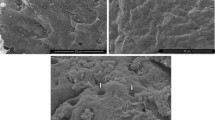Abstract
Escherichia coli O157:H7 culture filtrate (O157CF) produced colonic and renal lesions in mice following intraperitoneal or intravenous injection. Colonic lesions were characterized by death and sloughing of both surface and crypt epithelial cells, leading to loss of the mucous membrane and subsequent occult colonic hemorrhage. Several areas of severe colonic damage existed where loss of the epithelium and lamina propria was complete, leaving only the submucosal and smooth muscle layers intact. The colon was the only portion of the gastrointestinal tract affected by O157CF. Renal lesions were characterized by marked vacuolation and general necrosis of proximal convoluted tubular cells, and the presence of numerous exfoliated renal epithelial cells in the lumina of distal convoluted and collecting tubules. A neurogenic response was demonstrated by paralysis of the animals' rear extremities. The mouse was a useful model for detecting and studying in vivo the toxic properties of O157CF.
Similar content being viewed by others
Literature Cited
Black, S. D., Jones, N. F. (eds.). 1979. Renal disease, 4th edn., pp. 437–493. Blackwell, London.
Brenner, B. M., Stein, J. H. (eds.). 1980. Acute renal failure, pp. 123–162. Churchill Livingstone, New York.
Brinn, N. T., Pickett, J. P. 1979. Glycol methacrylate for routine, special stains, histochemistry, enzyme histochemistry and immunohistochemistry: a simplified cold method for surgical biopsy tissue. Journal of Histotechnology2:125–130.
Deetz, T. R., Evans, D. J., Jr., Evans, D. G., DuPont, H. L. 1979. Serologic responses to somatic O and colonizationfactor antigens of enterotoxigenicEscherichia coli in travelers. Journal of Infectious Diseases140:114–118.
Jahnson, W. M., Lior, H., Bezanson, G. S. 1983. CytotoxicEscherichia coli O157:H7 associated with haemorrhagic colitis in Canada. Lancet1:76.
Karmali, M. A., Petric, M., Steele, B. T., Lim, C. 1983. Sporadic cases of haemolytic-uraemic syndrome associated with faecal cytotoxin and cytotoxin-producingEscherichia coli in stools. Lancet1:619–620.
Keusch, G. T., Donohue-Rolfe, A., Jacewicz, M. 1982.Shigella toxin(s): description and role in diarrhea and dystentery. Pharmacology and Therapeutics15:403–438.
Kirschenbaum, M. A. 1978. Practical diagnosis: renal disease, pp. 25–98. Houghton-Miffin, Boston.
Lee, R. L. 1977. 2-Hydroxyethyl methacrylate embedded tissues: a method complementary to routine paraffin embedding. Medical Laboratory Sciences34:231–239.
Lillie, R. D., Fuller, H. M. (eds.). 1976. Histopathologic technic and practical histochemistry, 4th edn., pp. 635–636. McGraw-Hill, New York.
Neter, E., Westphal, O., Lüderitz, O., Gorzynski, E. A., Eichenberger, E. 1956. Studies on the enterobacterial lipopolysaccharides: effects of heat and chemicals on erythrocyte-modifying, antigenic, toxic and pyrogenic properties. Journal of Immunology76:377–385.
O'Brien, A. D., Lively, T. A., Chen, M. E., Rothman, S. W., Formal, S. B. 1983.Escherichia coli O157:H7 strains associated with haemorrhagic colitis in the United States produce aShigella dysenteriae 1 (Shiga) like cytotoxin. Lancet1:702.
O'Brien, A. D., Lively, T. A., Chang, T. W., Gorbach, S. L. 1983. Purification ofShigella dysenteriae 1 (Shiga)-like toxin fromEscherichia coli O157:H7 strain associated with haemorrhagic colitis. Lancet2:573.
O'Brien, A. D., Chen, M. E., Holmes, R. K., Kaper, J., Levine, M. M. 1984. Environmental and human isolates ofVibrio cholerae andVibrio parahaemolyticus produce aShigella dysenteriae 1 (Shiga)-like cytotoxin. Lancet1:77–78.
Riley, L. W., Remis, R. S., Helgerson, S. D. McGee, H. B., Wells, J. G., Davis, B. R., Hebert, R. J., Olcott, E. S., Johnson, L. M., Hargett, N. T., Blake, P. A., Cohen, M. L. 1983. Hemorrhagic colitis associated with a rareEscherichia coli serotype. New England Journal of Medicine308:681–685.
Robbins, S. L., Cotran, R. S. (eds.), 1979. Pathologic basis of disease. 2nd edn., pp. 111–1185. W. B. Saunders, Philadelphia.
Stewart, P. J., Desormeaux, W., Chéné, J. 1983. Hemorrhagic colitis in a home for the aged-Ontario. Canadian Disease Weekly Report9:29–32.
Woodruff, J. M., Greenfield, S. A. 1979. Advantage of glycol methacrylate embedding systems for light microscopy. Journal of Histotechnology2:14–167.
Author information
Authors and Affiliations
Rights and permissions
About this article
Cite this article
Beery, J.T., Doyle, M.P. & Higley, N.A. Cytotoxic activity ofEscherichia coli O157:H7 culture filtrate on the mouse colon and kidney. Current Microbiology 11, 335–342 (1984). https://doi.org/10.1007/BF01567702
Issue Date:
DOI: https://doi.org/10.1007/BF01567702




